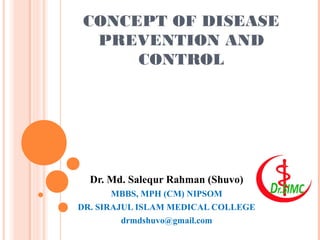
Concept of disease prevention and control 1234
- 1. CONCEPT OF DISEASE PREVENTION AND CONTROL Dr. Md. Salequr Rahman (Shuvo) MBBS, MPH (CM) NIPSOM DR. SIRAJUL ISLAM MEDICAL COLLEGE drmdshuvo@gmail.com
- 2. In disease control, the disease agent is permitted to persist in the community at a level where it ceases to be a public health problem according to the tolerance of local community. For example Malaria control programme. Disease control activities focus on primary prevention Disease Control drmdshuvo@gmail.com
- 3. The term ‘elimination” is used to describe interruption of transmission of disease. For example, elimination of measles, polio or diphtheria from large geographic area or region. It is intermediate step between control and eradication. Disease Elimination drmdshuvo@gmail.com
- 4. DISEASE ERADICATION It is an absolute process. Tear out by root. Eradication of disease implies termination of all transmission of infection by extermination of the infectious agent. This term is reserved for cessation of infection and disease from the whole world. The only disease eradicated from the world is “Small Pox” drmdshuvo@gmail.com
- 5. 1. There must not be any extra-human reservoir. 2. The incubation period should be short. 3. There must be an effective vaccine available. Measles, poliomyelitis and diphtheria are the diseases those can be eradicated. Criteria of a disease to be eradicated drmdshuvo@gmail.com
- 6. Control Eradication Definition To reduce incidence to acceptable level e.g. malaria control Total cessation of disease agent, e.g. Small Pox eradication Objective To reduce mortality and morbidity To uproot the disease Area of operation In high incidence area Total coverage Duration of operation Long follow up Time limited Economic aspect Expensive Cheap Case finding, confirmation, Epidemiological investigation Not important Very important Difference between control and eradicationDifference between control and eradication drmdshuvo@gmail.com
- 7. MONITORING Defined as “the performance and analysis of routine measurement, aimed at detecting changes in the environment or health status of population.” Exm: Growth monitoring of child, Monitoring of air pollution, Monitoring of water quality etc. drmdshuvo@gmail.com
- 8. SURVEILLANCE: Defined as “the continuous scrutiny of the factors that determine the occurrence and distribution of disease and other conditions of ill health.” E.g. Poliomyelitis surveillance programme of WHO. drmdshuvo@gmail.com
- 9. MODES OF INTERVENTION Intervention is any attempt to intervene or interrupt the usual sequence in the development of disease. Health Promotion Specific Protection Early Diagnosis and Adequate Treatment Disability Limitation Rehabilitation drmdshuvo@gmail.com
- 10. HEALTH PROMOTION Health Education Environmental Modifications Nutritional Interventions Lifestyle and Behavioral Change drmdshuvo@gmail.com
- 11. SPECIFIC PROTECTION Immunization Use of specific Nutrients Chemoprophylaxis Protection against Occupational Hazards Avoidance of Allergens Control of specific hazards in general environment Control of Consumer Product Quality & Safety drmdshuvo@gmail.com
- 12. EARLY DIAGNOSIS & TREATMENT Though not as effective and economical as ‘Primary Prevention’, early detection and treatment are the main interventions of disease control, besides being critically important in reducing the high morbidity and mortality in certain diseases like hypertension, cancer cervix, and breast cancer. The earlier the disease is diagnosed and treated the better it is from the point of view of prognosis and preventing the occurrence of further cases (secondary cases) or any long term disability. drmdshuvo@gmail.com
- 13. DISABILITY LIMITATIONS The Objective is to prevent or halt the transition of the disease process from impairment to handicap. Sequence of events leading to disability & handicap: Disease → Impairment → Disability→ Handicap drmdshuvo@gmail.com
- 14. DISABILITY LIMITATIONS Impairment: Loss or abnormality of psychological, physiological/anatomical structure or function. Disability: Any restriction or lack of ability to perform an activity in a manner considered normal for one’s age, sex, etc. Handicap: Any disadvantage that prevents one from fulfilling his role considered normal. drmdshuvo@gmail.com
- 15. REHABILITATION Rehabilitation has been defined as the ‘combined and coordinated use of medical, social, educational and vocational measures for training and retraining the individual to the highest possible level of functional ability” Areas of concern in rehabilitation: Medical Rehabilitation Vocational Rehabilitation Social Rehabilitation Psychological Rehabilitation drmdshuvo@gmail.com
- 16. CONCEPT OF PREVENTION Primordial Prevention Primary Prevention Secondary Prevention Tertiary Prevention drmdshuvo@gmail.com
- 17. LEVELS OF PREVENTION Primordial Prevention : Prevention from Risk Factors. Prevention of emergence or development of Risk Factors. Discouraging harmful life styles. Encouraging or promoting healthy eating habits. drmdshuvo@gmail.com
- 18. LEVELS OF PREVENTION Primary Prevention: Pre-pathogenesis Phase of a disease. Action taken prior to the onset of the disease: Immunization & Chemo-prophylaxis drmdshuvo@gmail.com
- 19. LEVELS OF PREVENTION Secondary Prevention: Halt the progress of a disease at its incipient phase. Early diagnosis & Adequate medical treatment. drmdshuvo@gmail.com
- 20. LEVELS OF PREVENTION Tertiary Prevention: Intervention in the late Pathogenesis Phase. Reduce impairments, minimize disabilities & suffering. Measures are: 1. Disability limitation 2. Rehabilitation drmdshuvo@gmail.com
- 21. COMMUNITY DIAGNOSIS Community diagnosis generally refers to the identification and quantification of health problems in a community as a whole in terms of mortality and morbidity rates and ratios, and identification of their correlates for the purpose of defining those at risk or those in need of health care. drmdshuvo@gmail.com
